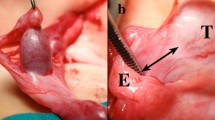Abstract
A mutant rat (TS) has been described with so-called ectopic scrotum, but the published photograph suggested that only the testes were ectopic. We established a colony of these inbred rats as a possible model for cryptorchidism. Five breeding pairs were obtained from the Imamichi Institute, Japan. Immature male offspring (0–21 days) were examined macro- and microscopically to document inguinoscrotal anatomy and gubernacular development. Uni- or bilateral, suprainguinal ectopic testes occurred in 39/46 males. Abnormal gubernacular position was visible microscopically by 3 days and macroscopically by 3–7 days of age. The processus vaginalis, cremaster muscle, and epididymis developed normally. The scrotum was hypoplastic but in the normal position. The TS rat is a new animal model for superficial inguinal ectopic testes, and will be invaluable for elucidating the cause of cryptorchidism and studying the effects of treatment. Our preliminary morphological studies suggest that the gubernaculum develops properly, but appears to migrate in the wrong direction.
Similar content being viewed by others
References
Backhouse KM (1982) Embryology of testicular descent and maldescent. Urol Clin North Am 9: 315–325
Beasley SW, Hutson JM (1987) Effect of division of the genitofemoral nerve on testicular descent in the rat. Aust NZ J Surg 57: 49–51
Hadziselimovic H (1980) Etiology of testicular descent. Clin Androl 3: 138–147
Hecker WC, Heinz HA (1967) Cryptorchidism and fertility. J Pediatr Surg 2: 513–517
Hutson JM, Beasley SW (1987) The mechanisms of testicular descent. Aust Paed J 23: 215–216
Hutson JM, Williams MPL, Attah A, Larkins S, Fallat ME (1990) Undescended testes remain a dilemma despite recent advances in research. Aust NZ J Surg 60: 429–439
Hutson JM, Williams MPL, Fallat ME, Attah A (1990) Testicular descent: new insights into its hormonal control. Oxf Rev Reprod Biol 12: 1–56
Ikadai H, Ajisawa C, Taya K, Imamichi T (1988) Suprainguinal ectopic scrota of TS inbred rats. J Reprod Fert 84: 701–707
Jones PG (1966) Undescended testes. Aust Pediatr 2: 36–48
Lamm DL, Kaplan GW (1977) Accessory and ectopic scrota. Urology 9: 149–153
Lewis LG (1948) Cryptorchidism. J Urol 60: 345–356
Mouhadjer N, Pointis G, Malassine A, Bedin M (1989) Testicular steroid sulfatase in a cryptorchid rat strain. J Steroid Biochem 34: 555–558
Rajfer J, Walsh PC (1977) Hormonal regulation of testicular descent: experimental and clinical observations. J Urol 118: 985–990
Scorer CG (1964) The descent of the testis. Arch Dis Child 39: 605–609
Wensing CJG, Colenbrander B (1986) Normal and abnormal testicular descent. Oxf Rev Reprod Biol 8: 130–164
Author information
Authors and Affiliations
Additional information
Offprint requests to: J. M. Hutson
Rights and permissions
About this article
Cite this article
Park, WH., Hutson, J.M. A new inbred rat strain (TS) with suprainguinal ectopic testes: a model for human cryptorchidism. Pediatr Surg Int 6, 172–175 (1991). https://doi.org/10.1007/BF00176062
Issue Date:
DOI: https://doi.org/10.1007/BF00176062




